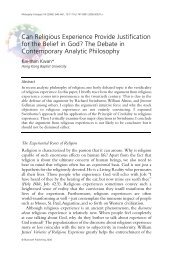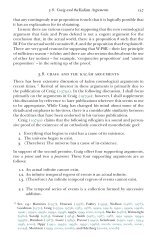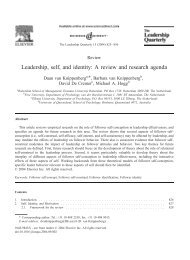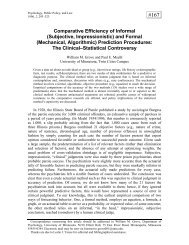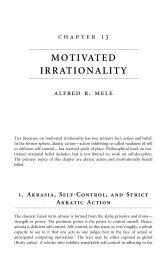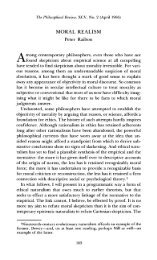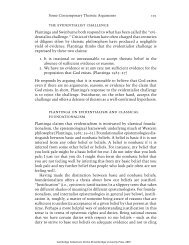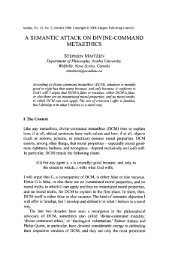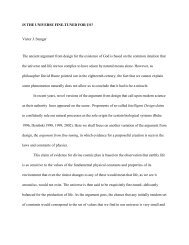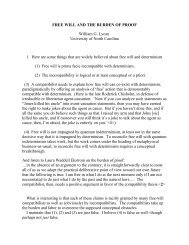Atheism and Theism JJ Haldane - Common Sense Atheism
Atheism and Theism JJ Haldane - Common Sense Atheism
Atheism and Theism JJ Haldane - Common Sense Atheism
Create successful ePaper yourself
Turn your PDF publications into a flip-book with our unique Google optimized e-Paper software.
Further Reflections on <strong>Atheism</strong> 211<br />
omnipotence, savours a bit of magic. God said, ‘Let there be light’ <strong>and</strong> there<br />
was light. This cannot refer to word magic, as when a conjurer pretends that<br />
the rabbit comes out of the hat by his saying ‘Abracadabra’. The notions of<br />
theology are not easily made sense of. The theist’s view of God’s transcendence<br />
makes this difficulty for theology unsurprising, but if the notions of<br />
theology are of an object that is entirely beyond our underst<strong>and</strong>ing, then this<br />
makes them useless for explanation.<br />
Neil A. Manson has presented an interesting challenge to the proponents<br />
of the fine-tuning argument in an article ‘There is no adequate definition of<br />
“Fine-Tuning for Life”’. 22 Without attempting here to summarise or make a<br />
proper critique of his article I shall make a few points which may be taken<br />
as a present to the theist.<br />
One may doubt whether a general definition has to be possible. The notion<br />
to seems to me to be context-dependent. Thus one may agree with Manson’s<br />
remark that there should be no astonishment in the fact that if Michael<br />
Jordan’s height had been one part in 10 16 of a light year different he would<br />
not have been the world’s greatest basketball player. As Manson concedes,<br />
the statement has to be made in relation to the known background information,<br />
the range of variation of human beings <strong>and</strong> in particular of basketball<br />
players. Note also that it does not matter whether we say 10 −16 light years<br />
shorter or one metre shorter. Nor in other cases whether we say ‘grams’ or<br />
‘pounds’, or ‘feet’ or ‘metres’. ‘Slightly’ has to be elucidated in relation to pure<br />
numbers, namely ratios, <strong>and</strong> of course the ratios are the same in either case. With<br />
multiple fine tunings we would deal also with ratios of ratios. In parenthesis<br />
I would like to add that the contextual <strong>and</strong> minimalist account of counterfactuals<br />
would suffice for the present considerations.<br />
More powerfully, I think, Manson points out that ‘slightly’ says nothing<br />
about probability. Nevertheless in context it may. Thus in the usual<br />
cosmological case the context is that of symmetry breaking. Consider the<br />
analogy in classical mathematics of a needle vertically on its tip at a point O<br />
which is the centre of a circle. Suppose that the other end of the needle falls<br />
at a point Q on the circle <strong>and</strong> somehow detonates a bomb if OQ is within a<br />
small angle to a radius OP. Surely in this classical case ‘slightly’ refers to the<br />
ratio of this small angle to the angle 2π.<br />
It is plausible enough here that the smallness of this ratio gives a measure<br />
of improbability. Similarly it is not clear that the symmetry breaking of the<br />
proto-laws just after the beginning of the big bang might not suggest a<br />
probability metric.<br />
If the range of possible cases were not finite, taking a case to be ‘within<br />
a specifiable small angle’ as in the example of the needle, were given by an<br />
infinite line, then all variations, large or small would have probability of zero.<br />
Still, this could be taken as strengthening the theist’s case. Here I am concerned



